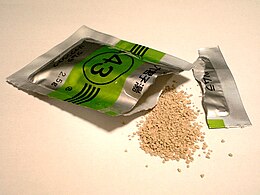Rikkunshito
Le rikkunshito[1] , ou Rikkunshi-tō , correspond à la formule numéro 43 de la médecine kampo[2]. C'est une préparation médicinale japonaise[3] utilisée dans le traitement de l'anorexie et le dyspepsie fonctionnelle[2].
Le rikkunshito est composé de huit plantes :
18,6% Atractylodis Lanceae (ja) Rhizoma (nom japonais: sojutsu), 18,6% Ginseng Radix (nom japonais: ninjin), 18,6% Pinelliae Tuber (nom japonais: hange), 18,6% Hoelen (nom japonais: bukuryo), 9,3% Zizyphi Fructus (nom japonais: taiso), 9,3% Aurantii Nobilis Pericarpium (nom japonais: chinpi), 4,7% Glycyrrhizae Radix (nom japonais: kanzo) et 2,3% Zingiberis Rhizoma (nom japonais: shokyo) [4] ,[1],[5].
Le rikkunshito favorise la sécrétion de ghréline dans l'estomac, augmente la sensibilité des récepteurs de la ghréline, et améliore la motilité gastrointestinale[1],[4].
Voir aussi[modifier | modifier le code]
Références[modifier | modifier le code]
- (en) Miwa Nahata, Shuichi Muto, Nobuhiko Oridate et Shunsuke Ohnishi, « Impaired ghrelin signaling is associated with gastrointestinal dysmotility in rats with gastroesophageal reflux disease », American Journal of Physiology-Gastrointestinal and Liver Physiology, vol. 303, no 1, , G42–G53 (ISSN 0193-1857 et 1522-1547, PMID 22517773, PMCID PMC3404573, DOI 10.1152/ajpgi.00462.2011, lire en ligne, consulté le )
- « Additive effect of rikkunshito, an herbal medicine, on chemotherapy-induced nausea, vomiting, and anorexia in uterine cervical or corpus cancer patients treated with cisplatin and paclitaxel: results of a randomized phase II study (JORTC KMP-02) »
- K. Tominaga, T. Kido, M. Ochi et C. Sadakane, « The Traditional Japanese Medicine Rikkunshito Promotes Gastric Emptying via the Antagonistic Action of the 5-HT3 Receptor Pathway in Rats », Evidence-based Complementary and Alternative Medicine : eCAM, vol. 2011, , p. 248481 (ISSN 1741-427X, PMID 19861508, PMCID 3095508, DOI 10.1093/ecam/nep173, lire en ligne, consulté le )
- Tomohisa Hattori, « Rikkunshito et Ghrelin », : « it has recently been shown that oral administration of rikkunshito stimulates secretion of the orexigenic peptide, ghrelin, from the stomach »
- Mineji Hayakawa, Yuichi Ono, Takeshi Wada et Yuichiro Yanagida, « Effects of Rikkunshito (traditional Japanese medicine) on enteral feeding and the plasma ghrelin level in critically ill patients: a pilot study », Journal of Intensive Care, vol. 2, no 1, , p. 53 (ISSN 2052-0492, PMID 25705411, PMCID PMC4336131, DOI 10.1186/s40560-014-0053-4, lire en ligne, consulté le ) :
« Rikkunshito est extrait d'un mélange de Glycyrrhizae radix (4,7%), Zingiberis rhizoma (2,3%), Atractylodis lanceae rhizoma (18,6%), Zizyphi fructus (9,3%), Aurantii nobilis pericarpium (9,3%), Ginseng radix (18,6%) , tubercule de Pinelliae (18,6 %) et Hoelen (18,6 %) »

